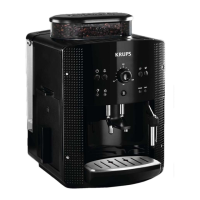54
ENGLISH
PREPARING ESPRESSO AND LONG COFFEES
Remember to t the drip tray to avoid waste water owing onto the work surface and
staining it or scalding you.
Check that your water tank is clean.
Initialisation cycle - total duration: around 3 minutes
Turn on the appliance by pressing the button - Fig. 5. The light is constant.
Put a container with a minimum capacity of 0.6 litres underneath the two coffee outlets and
steam nozzle.
Press the - Fig. 6 button: the appliance starts the initialisation cycle for rinsing of the
steam and coffee circuits. The light ashes.
The cycle is nished when the light becomes constant. The appliance is now ready to
use.
It is preferable to rinse the 2 circuits out at least once after the appliance has not
been used for several days. Each time you plug your appliance in, it will carry out an
initialisation cycle.
Preparing the grinder
You can choose the strength of your coffee by setting the coffee bean grinding neness.
The ner the grinding setting, the stronger and creamier the coffee should be. Set the
desired neness for grinding by turning the ‘Grinding neness setting’ knob. Turn to the left
for ner grind. Turn to the right for coarser grind.
NEVER CHANGE THE SETTING DURING GRINDING.
Never force the grinding fineness setting button.
YOUR APPLIANCE IS DESIGNED TO MAKE COFFEE FROM COFFEE BEANS ONLY
When you first make coffee with the appliance or after a long period of absence or a
cleaning or scale removal procedure, a little steam and hot water will come out of the
steam nozzle (priming).
Splashing or scalding may occur if the coffee outlets are set too high in relation to the
size of the cups.
Note:
The amount of water needed to make an espresso is between 30 and 70 ml.
The amount of water needed to make a coffee is between 80 and 220 ml.
Production of an espresso or coffee
Plug in your appliance.
Press the button . The light will ash during the pre-heating and initialisation cycle.
The light becomes constant.
Put a cup under the coffee outlets. You can lower or raise the coffee outlets to suit the size
of your cups - Fig. 7.
Select the key to get a strong espresso or the key to get a standard espresso - Fig. 8.
You can change the volume of water at any time - Fig. 9.
To stop coffee owing into the cup, you can either again press one of the or , keys or
turn the knob to the min. position.
The ground coffee is moistened with a little hot water after the grinding stage. A few
moments later, percolation as such starts. Beyond a certain amount of coffee in the
cup, we recommend - in order to obtain a stronger coffee - to divide your preparation
into two separate cycles. Example 2 x 70 ml cycles for a cup of 140 ml.
2 cup function
You can prepare 2 cups of coffee or espresso with your appliance.
Press the button
the light ashes during the pre-heating of the appliance The light
becomes constant.
Place 2 cups under the coffee outlets. You can lower or raise the coffee outlets to suit the
size of your cup- Fig. 10.
Select the button
or according to your choice, by quickly pressing the button twice.
The light
comes on with a double ash to inform you that you have requested two cups
of coffee.
The appliance will automatically sequence 2 complete coffee-making cycles.
Make sure that you don’t remove the cups after the first cycle.
If you press the
button once and the button a second time (or the other way round),
the second one isn’t taken into account.
PREPARING STEAM
Steam froths up the milk to make a cappuccino or a caffe latte, for example, and also heats
up liquids. As you need a higher temperature to produce steam than to make an espresso,
the appliance runs an additional pre-heating phase for steam.
Plug in your appliance.
Press the
button: the light ashes during the pre-heating of the appliance.
The light
becomes constant.
Press the button - Fig. 11.
The light
ashes during the pre-heating.
Once the pre-heating is nished, the light
stays constant and you can start the steam
production by pressing the button again.
Press the button again to stop the cycle.
The appliance goes back to its initial position if the steam control is not used after 2
mins.
BE CAREFUL. BECAUSE THE CYCLE DOES NOT STOP IMMEDIATELY
Frothing milk
We recommend that you use pasteurised or UHT milk that has been recently opened.
Untreated milk does not give the best results.
Pour the milk into your milk jug. Immerse the nozzle in the milk - Fig. 12.
Initiate the steam function as explained in the paragraph above.
Once your milk is frothy enough - Fig. 13 - again press the key to stop the cycle.
To remove any milk traces from the steam nozzle, place a container under the nozzle and
restart a preparation with steam (around 10 seconds).
The steam nozzle can be removed for more intense cleaning. Wash it out with water and a

